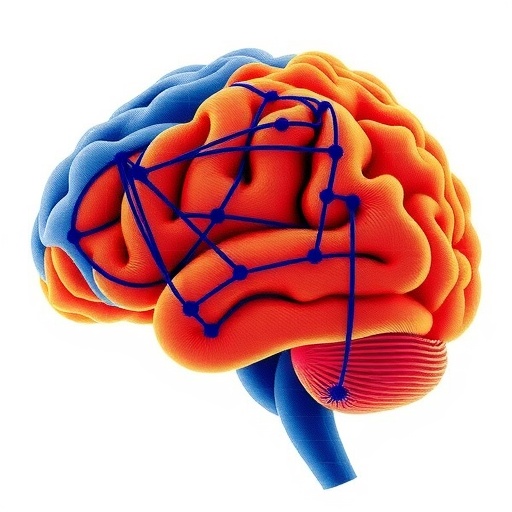In a remarkable leap forward for our understanding of how the brain carries out sensory inference, a study published in Nature Neuroscience reveals the crucial role that recurrent pattern completion plays in shaping the neocortical representation of sensory information. The research, conducted by Shin, Ogando, Abdeladim, and colleagues, elucidates the intricate computational mechanisms the brain employs to relentlessly infer and reconstruct sensory inputs, despite noise, ambiguity, and incomplete data. This discovery not only deepens our grasp of neocortical function but also has profound implications for artificial intelligence, neural prosthetics, and the treatment of sensory-processing disorders.
Sensory inference—the brain’s ability to predict and interpret the environment from fragmented and noisy sensory signals—is a canonical problem in neuroscience. Traditionally, sensory inputs have been viewed as largely feedforward cascades in neural pathways, wherein information flows unidirectionally from peripheral sensors to higher cortical areas. However, this simplistic view fails to capture the brain’s remarkable ability to infer entire perceptual scenes from incomplete data. The new study proposes that recurrent circuits within the neocortex perform sophisticated pattern completion, enabling a dynamic and robust internal model of sensory inputs.
At the core of the study lies the concept of recurrent pattern completion, a process by which partially observed stimuli trigger the activation of entire neural ensembles that represent complete sensory patterns. This mechanism leverages recurrent connectivity—where neurons project back onto themselves and their neighbors—to “fill in the gaps” of missing or ambiguous data. Through this recursive interaction, the neocortex generates stable activity patterns that correspond to coherent sensory experiences, even when sensory inputs are fragmented or degraded.
The authors employed cutting-edge experimental techniques, combining in vivo two-photon calcium imaging with sophisticated optogenetics in awake, behaving mice. These methods allowed unprecedented observation and manipulation of the recurrent circuits in layer 2/3 of the primary sensory cortex during sensory tasks that required the animals to infer stimulus identity under noisy conditions. By selectively activating or silencing subsets of neurons, the team could tease apart the causal role of recurrent circuits in pattern completion and sensory inference.
An important technical achievement of the study was the application of advanced computational modeling to analyze the neural dynamics observed. Employing recurrent neural network models trained to mimic the observed cortical activity, the researchers demonstrated how pattern completion emerges naturally from the intrinsic connectivity and synaptic plasticity rules of the neocortex. This theoretical framework illuminated how recurrent interactions stabilize neural representations and make them robust against sensory noise.
The implications of this discovery stretch far beyond sensory neuroscience. From a computational perspective, the brain’s recurrent pattern completion strategy mirrors some of the most prominent deep learning architectures, particularly those utilizing feedback loops and generative models that excel at reconstructing missing data. This convergence of biological and artificial computation opens exciting avenues for developing more brain-like AI systems capable of human-level sensory inference under uncertainty.
Moreover, these insights have potential clinical relevance. Sensory-processing disorders such as autism spectrum disorder and schizophrenia often involve impaired sensory integration and inference. Understanding the neural basis of sensory pattern completion could inspire new diagnostic markers or targeted interventions aimed at restoring the integrity of recurrent circuits, thus ameliorating perceptual abnormalities and improving sensory-based cognitive functions.
One of the particularly intriguing aspects uncovered is that these recurrent circuits do not merely echo feedforward sensory signals; rather, they actively reshape and enhance sensory representations. This dynamic interplay suggests that the neocortex leverages recurrent connectivity not just for amplification but for a reconstructive inference process that models the external world in real time. Such a model self-corrects and updates through continuous sensory feedback, maintaining perceptual stability despite environmental fluctuations.
In addition to empirical evidence, the study highlights how recurrent networks confer a form of resilience to the sensory system. By completing patterns based on partial input, the neocortex can maintain perceptual constancy amid sensory disruptions—a feature fundamental to perception in naturalistic settings. This adaptive benefit underscores why recurrent architecture is so evolutionarily conserved across mammalian neocortex.
In dissecting the circuitry, the researchers identified distinct neuron subpopulations within layer 2/3 of the primary sensory cortex that differentially contribute to encoding and completing sensory patterns. Pyramidal neurons formed the backbone of recurrent loops, while inhibitory interneurons modulated the precision and timing of pattern completion. This cell-type specificity adds a critical dimension to our understanding of how complex neural computations are realized at a microcircuit level.
The study also emphasizes that recurrent pattern completion is context-dependent and experience-dependent. Sensory inference dynamically adjusts based on prior sensory history and current behavioral states, indicating that the neocortex operates as a predictive engine that continuously updates its internal models. This finding resonates with the predictive coding theories of brain function, while providing direct mechanistic evidence of the cortical substrates involved.
From a methodological standpoint, the integration of precise optogenetic perturbation with real-time imaging in awake animals represents a powerful approach to unravel the causal circuitry of sensory inference. The capacity to manipulate targeted circuits with temporal precision while monitoring downstream effects is a game-changer, enabling researchers to move beyond correlative observations toward definitive mechanistic insights.
Looking ahead, the authors propose extending this line of research to other cortical regions and modalities. For example, recurrent pattern completion mechanisms may differ or evolve in association cortices responsible for more complex cognitive functions, such as memory or decision making. Exploring these gradients of recurrent processing across cortical hierarchies promises to refine our understanding of brain-wide sensory and cognitive computations.
Finally, this study shines a spotlight on how intertwined neural architecture and computational algorithms are within the brain. The recurrent connectivity of the neocortex is not a simple wiring feature but a fundamental computational substrate for inference, prediction, and perception. By unraveling these mechanisms, science moves closer to demystifying the neural basis of consciousness and cognition.
In summary, this groundbreaking research provides compelling evidence that recurrent pattern completion within neocortical circuits underpins the brain’s ability to infer sensory information reliably from incomplete data. Through elegant experimentation and modeling, Shin and colleagues illuminate the dynamic synergy between recurrent neural loops and sensory processing, reshaping long-held views on cortical computation. Their findings herald new directions in neuroscience and artificial intelligence, offering a blueprint for how brains—and machines inspired by them—can perceive a noisy and fragmented world with remarkable fidelity.
Subject of Research: Neocortical mechanisms underlying sensory inference via recurrent pattern completion.
Article Title: Recurrent pattern completion drives the neocortical representation of sensory inference.
Article References:
Shin, H., Ogando, M.B., Abdeladim, L. et al. Recurrent pattern completion drives the neocortical representation of sensory inference. Nat Neurosci (2025). https://doi.org/10.1038/s41593-025-02055-5
Image Credits: AI Generated
Tags: advanced neural circuitryartificial intelligence implicationscomputational mechanisms of the braindynamic internal models of perceptionincomplete sensory data interpretationneocortical sensory inferenceneural prosthetics researchnoise and ambiguity in sensory signalspredictive modeling in neurosciencerecurrent pattern completionsensory processing disordersunderstanding sensory information reconstruction





